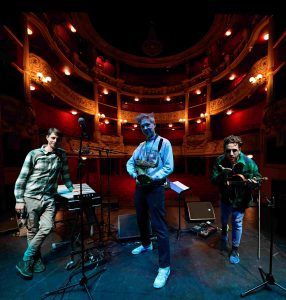Daniel Erdmann_tenor sax
Theo Ceccaldi_viola & Violin
Jim Hart_vibraphon
NEW CD: Message In A Bubble BMC Records, 09/2023
Daniel Erdmann’s Velvet Revolution – Message In A Bubble
Velvet, the third. After a moment of weightlessness (A Short Moment of Zero G, 2016) and the refusal to follow a flag (Won’t Put No Flag Out, 2019), now messages from a bubble (Message in a Bubble).
Message in a Bubble – of course, the onomatopoeia-like hit by Gordon Sumner immediately comes to mind, whose bass figure prompted Gil Evans to collaborate with the (then still, albeit already infected with the jazz virus) rock musician in the late 1980s. Sting’s hit told of a man stranded on an island who throws a message in a bottle into the sea to ward off his loneliness. Hoping to make contact with the outside world. One morning, after more than a year has passed without an answer, he comes to the beach and finds countless bottles with messages addressed to him. The key line of the song lyrics: “Seems I’m not alone at being alone”.
This is where Daniel Erdmann attacks: The ‘Velvet Revolutionaries’ set a sign of hope against the loneliness experienced to the core (in various gradations) at the time of the pandemic. It is not an ‘SOS’ that emanates from Velvet, but the hope for an end to aloneness, for exchange, for togetherness. Hope that the ‘bubble’ will break open – not only in the pandemic sense. Reasonable scepticism in view of the extra-musical reality included. Daniel Erdmann always makes the general visible in the obvious, in the individual and the particular.
The trio – Daniel Erdmann, Theo Ceccaldi and Jim Hart – lives this togetherness: since its formation in 2015/16, it has organically developed into a band in which the whole is more than the sum of its individual parts. Although it is entirely Daniel Erdmann’s project, Theo Ceccaldi and Jim Hart have clearly ’emancipated’ themselves over time. This already became clear on the recordings for the second album with the greater improvisational share of the two. The same continues here. In addition, they each contribute three compositions to the nine tracks on the CD. This is something that has been Daniel Erdmann’s concern from the beginning. If there is one quality – apart from Daniel Erdmann’s highly rated musical abilities as a player, composer and arranger – that can be described as his strength, it is this: He is able to make ‘his’ musicians better in the sense that they let his project become theirs, internalise the sound he had in his ear when he once set out to find the musicians with whom this sound could become reality.
What emerges; an intense and dense interwoven music-making, a somnambulistic certainty of response, a deeply soulful give and take.
Just one example: Jim Hart opens the first piece (penned by Theo Ceccaldi) with an ostinato rhythmic figure on the vibraphone, over which Theo Ceccaldi improvisationally sets melodic accents with the viola, which Daniel Erdmann’s saxophone picks up, Theo Ceccaldi’s now plucked instrument lays a rhythmic foundation underneath, which is then taken up by Daniel Erdmann and gives Jim Hart the space for improvisational flight and grounds him at the same time. A creative principle that is open in different transformations.
On this basis of emancipated togetherness, all three have the necessary space to tell their own stories musically. Coming from the melodic, the tradition – not only that of jazz – naturally in the material suitcase, which they assemble (or also take apart) at will and necessity from the baroque to atonality, chamber music symphonists with humour (The Velvet Tango), always breaking traditions and transgressing the boundaries of convention in search of the new, the unsaid, the still unknown, embracing reality and creating alternatives from it with imagination and passion.
Daniel Erdmann, a member and co-leader of many bands, had the sound of this trio in his ear and searched for and finally found the musicians who would allow the inner sound to become reality. Here is a band that carries his stamp, that of the tenor saxophonist and composer. At the same time, there is a lot of room for the participants in the ensemble playing. This kind of music is about freedom, the freedom to improvise in relation to the composition, the freedom to feel, to think and to wish.
It is the gesture, the closeness to language, the narrative and rhapsodic manner that first makes you sit up and take notice and that draws you in. Daniel Erdmann’s pieces are compact, sometimes even complex, and within their forms the participants can move freely. The themes, both musical and intellectual, form the frame of reference. Daniel Erdmann is an avowed melodist. And that is often much harder than hiding behind a material exegesis, because the ideas and the statements have to be strong. In this web of voices with violin, viola and vibraphone, he weaves a trio that allows the parts to share rhythmic or harmonic aspects, to overlap or develop.
French violinist Théo Ceccaldi contributes something from the great French string tradition, as well as jazz references and something very contemporary: he can wallow in melody, but also provide abstract, percussive action. Daniel Erdmann knows Jim Hart from a visit to London, where the vibraphonist, who now lives in Colmar, was one of the co-founders of the Loop Collective. With its luminous sound, the vibraphone magically reinforces the chamber music of the trio. Jim Hart, who is also a drummer, brings the rhythmic competence that allows him to brilliantly dispense with drums. The trio is a typical international band, like so many of Daniel Erdmann’s formations.
The trio is a typically international band, like so many of Daniel Erdmann’s line-ups. There is no proclamatory intention behind this, just the everyday reality and the tendency of this kind of European jazz to make distances and borders seem increasingly irrelevant.
Daniel Erdmann’s Velvet Revolution is free of intention, of the desire to illustrate, although it does contain a number of allusions. The music comes from the confrontation with reality and bubbles up from the imagination. It has something poetic and something anecdotal, something picturesque and something abstract. There is no need to know what the titles have to do with the pieces when the sounds speak for themselves.
Reviews:
Daniel Erdmann’s Velvet Revolution with French violinist extraordinaire Théo Ceccaldi and English percussion master Jim Hart (here solely on vibraphone) is a happy meeting of three kindred spirits and a tonal specialty. Theo Ceccaldi is one of the strongest, most dazzling and fanciful musicians of the younger French generation. As a ubiquitous musician he has made a strong mark. If the question “what connects German composer Hanns Eisler, Free Jazz, French musette and dub reggae?” arises, the answer no doubt will be saxophonist Daniel Erdmann from Germany, living and working now in France as well as in Berlin. He made a name with German-French-Danish group Das Kapital and worked in numerous highly profiled European groups. Jim Hart played an important role in the London LOOP collective and has made his mark in the British scene. He is now residing in France and found his allies in Velvet Revolution. Velvet Revolution is a true European group with a strong spirit, wit, great musical ideas as well as fantasy and capacity to make it work in captivating ways.
It’s not only the combination of instruments that is unique. The same applies to the playing. Fed by many sources, they act independently and together at the same time. They know what to play when, and how to arrive at a strong common theme, something that carries them along the predisposed into the imagined-in-the-moment. They are great at creating shifting atmospheres. It is heavy, then light again, firing at one moment and whispering the next. These and other remarkable qualities were accomplished in a cool hot way, brilliant and convincing right from the start of their 30 minute turn—a group with a strong European signature and the capacity to ignite something special for its audience. Velvet Revolution’s latest album A Short Moment Of Zero G was released by the exquisite BMC label of Budapest Music Center. Henning Bolte, All about jazz
But it is not only Erdmann’s concise compositions, specially designed for this trio, that give his band “Velvet Revolution†a striking charism. Thanks to their individual virtuosity, Erdmann, Ceccaldi and the British vibraphone player Jim Hart might even have their own spark from children’s songs or famous chansons. Their joy of playing and close-knit interaction are a pleasure, the connection of high art, vitality and fine humor succeeds exemplary. Live on stage many improvisations shed new light to the pieces: the three of them balancing on the high ropes of the free, but never overbearing, imagination. At the age of 43, Erdmann is a bit older than his partners, but his tone on the tenor saxophone sounds like an even bigger maturity. A warm, earthy timbre is the basis on which his melodies, which are soft, but definitely broken, can grow into hoarse booms, turn into rough shouts and fluttering modulation. Breath tingly sovereign in the choice of his means, Erdmann swaps between reduction and enrichment, his phrases are full of surprises. The principle of the jamboree bag, perhaps even a few facets more, applies to Théo Ceccaldi. Not even 31 years, he is rightly celebrated as a great discovery beyond France’s borders. Classically trained, Ceccaldi plays on violin and viola many things which are at least rarely to be heard in jazz. Full overtones or complex-polyphonic passages, fluttering flageolets in various shades, plucked motifs, scraping accents and stoically chipped chords show verve and wit. Beyond all the precisely executed caprices, Ceccaldi’s attitude and presence conveys deep passion. The third man, Jim Hart, born in 1978, studied piano and drums in London and has long made his mark as a vibraphonist. Meanwhile, at home in Alsace, Hart takes care of Velvet Revolution’s groove, sometimes he condenses fine-timed rhythmic braids, and sometimes also creates rattling tones and sweeps atmospheric sounds from the metal plates. Whether calm, floating or swinging, in parallel arcs or contrapuntal lines, together or individually, the three stylists always fascinate with sensitivity and nuanced expression. The unusual line-up and a striking artistic attitude make Daniel Erdmann’s Velvet Revolution a special, highly recommended experience. Norbert Krampf, FAZ
Trio Photo below, István Huszti
Trio Photo Below, Maxim Francois
Trio Photo below, nicolas dhondt
Daniel Erdmann below, photo Dirk Bleicker





 #
#